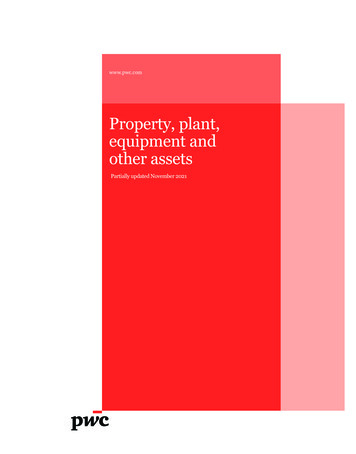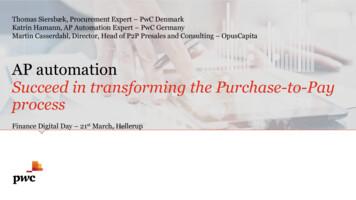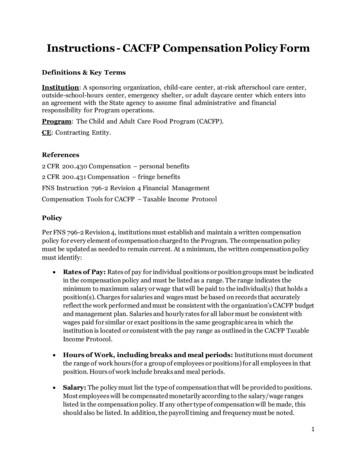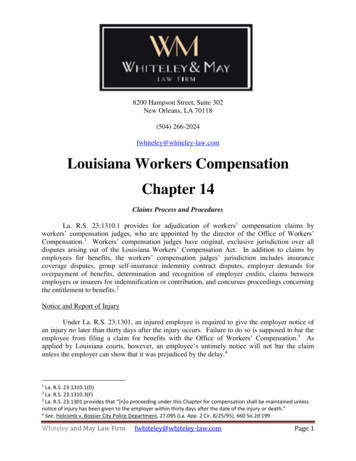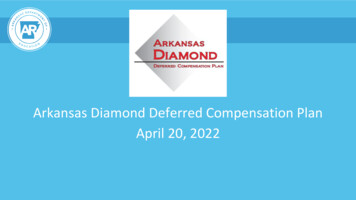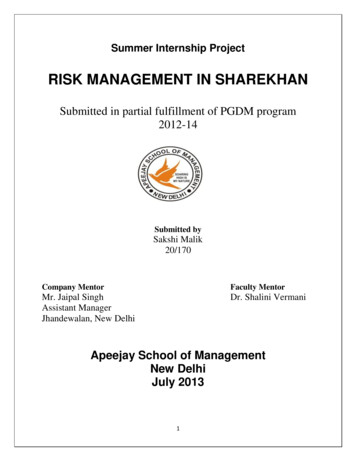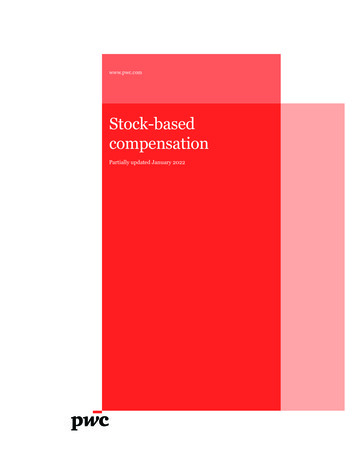
Transcription
www.pwc.comStock-basedcompensationPartially updated January 2022
About the Stock-based compensationguidePwC is pleased to offer our updated Stock-based compensation guide. This guide explains thefundamental principles of accounting for all types of stock-based compensation, including whicharrangements are subject to its scope, measurement date, vesting conditions, expense attribution, andclassification (i.e., liability or equity), as well as the accounting required when awards are modified.This guide also discusses the unique accounting for nonpublic companies, awards to nonemployees,employee stock purchase plans and employee stock ownership plans, as well as valuationconsiderations. This guide also provides our perspectives on the impact of the accounting guidance onstock-based compensation plan design, including a summary of employer and employee income taxconsiderations.This guide summarizes the applicable accounting literature, including relevant references to andexcerpts from the FASB’s Accounting Standards Codification (the Codification). It also provides ourinsights and perspectives, interpretative and application guidance, illustrative examples, anddiscussion on emerging practice issues.This guide should be used in combination with a thorough analysis of the relevant facts andcircumstances, review of the authoritative accounting literature, and appropriate professional andtechnical advice. Guidance on financial statement presentation and disclosure related to stock-basedcompensation can be found in PwC’s Financial statement presentation guide (FSP 15).References to US GAAPDefinitions, full paragraphs, and excerpts from the FASB’s Accounting Standards Codification areclearly labelled. In some instances, guidance was cited with minor editorial modification to flow in thecontext of the PwC Guide. The remaining text is PwC’s original content.References to other PwC guidanceThis guide provides general and specific references to chapters in other PwC guides to assist users infinding other relevant information. References to other guides are indicated by the applicable guideabbreviation followed by the specific section number. The other PwC guides referred to in this guide,including their abbreviations, are: Business combinations and noncontrolling interests (BCG) Derivatives and hedging (DH) Fair value measurements (FV) Financial statement presentation (FSP) Financing transactions (FG) Income taxes (TX)
About this guide Revenue from contracts with customers (RR)Summary of significant changesFollowing is a summary of the noteworthy revisions to the guide since it was last updated. Additionalupdates may be made to keep pace with significant developments.Revisions made in January 2022SC 2, Measurement date, vesting conditions, and expense attribution SC 2.1 was updated for SAB 120 relating to the SEC staff’s views on accounting for share-basedawards under ASC 718 that are granted shortly before a release of material non-public informationthat is expected to result in a material increase in share price.SC 3, Liability-classified awards Example SC 3-9 in SC 3.3.4.2 was added to illustrate the accounting for a combination awardwith a guaranteed minimum value settled in shares.SC 4, Modifications to stock-based compensation awards Example SC 4-8 in SC 4.5.2 was added to illustrate the accounting for a modification of stockoptions pursuant to an antidilution provision using a “make-whole” cash payment.SC 6, Nonpublic company stock-based compensation SC 6.2 was updated for ASU 2021-07, pertaining to a practical expedient for nonpublic companiesto determine the current price input of equity classified awards using a reasonable valuationmethod.Revision made in October 2021SC 10, Stock-based compensation plan design considerations Discussion on accounting for the employer’s portion of payroll taxes on employee stockcompensation was moved from PwC’s Income taxes guide (TX 17.3.2) to SC 10.7.3.Revisions made in September 2021SC 1, Stock-based compensation overview and scope SC 1.4 was updated to include an example of when an employee may earn an award granted by aneconomic interest holder. Example SC 1-2 in SC 1.8.2 was updated to include additional considerations on accounting forchanges in an employment relationship.
About this guideCopyrightsThis publication has been prepared for general informational purposes, and does not constituteprofessional advice on facts and circumstances specific to any person or entity. You should not actupon the information contained in this publication without obtaining specific professional advice. Norepresentation or warranty (express or implied) is given as to the accuracy or completeness of theinformation contained in this publication. The information contained in this publication was notintended or written to be used, and cannot be used, for purposes of avoiding penalties or sanctionsimposed by any government or other regulatory body. PricewaterhouseCoopers LLP, its members,employees, and agents shall not be responsible for any loss sustained by any person or entity thatrelies on the information contained in this publication. Certain aspects of this publication may besuperseded as new guidance or interpretations emerge. Financial statement preparers and other usersof this publication are therefore cautioned to stay abreast of and carefully evaluate subsequentauthoritative and interpretative guidance.The FASB material is copyrighted by the Financial Accounting Foundation, 401 Merritt 7, Norwalk, CT06856, and is reproduced with permission.
Chapter 1:Stock-based compensationoverview and scope—updatedSeptember 2021
Overview and scope1.1Stock-based compensation backgroundThe guidance in ASC 718, Compensation—Stock Compensation, applies to various types of equitybased awards that companies use to compensate their employees (see SC 1.5 regarding terminologyused in this guide). Under ASC 718, companies recognize the fair value of those awards in theirfinancial statements, generally beginning on the date the awards are granted. This guide covers thesignificant accounting aspects of ASC 718, with an emphasis on awards granted by public companies totheir employees. Additional considerations for employee awards granted by nonpublic companies arediscussed in SC 6. The accounting for awards granted to nonemployees is addressed in SC 7.This guide does not address the income tax, earnings per share, or cash flow implications of stockbased compensation awards nor other presentation and disclosure matters. Refer to the following PwCguide sections for guidance on those matters: TX 17 for guidance on income tax accounting consequences FSP 7.5.5.5 for earnings per share implications FSP 6.9.19 for cash flow statement considerations FSP 15 for guidance on the presentation and disclosure of stock-based compensationNew guidanceASU 2018-07In June 2018, the FASB issued ASU 2018-07, Compensation—Stock Compensation (Topic 718):Improvements to Nonemployee Share-Based Payment Accounting, to amend the accounting forshare-based payment awards issued to nonemployees. Under the revised guidance, the accounting forawards issued to nonemployees will be similar to the model for employee awards, except that: the ASU allows an entity to elect on an award-by-award basis to use the contractual term as theexpected term assumption in the option pricing model, and the cost of the grant is recognized in the same period(s) and in the same manner as if the grantorhad paid cash.The update was effective for public business entities for fiscal years beginning after December 15,2018, including interim periods within that fiscal year. For all other entities, the amendments areeffective for fiscal years beginning after December 15, 2019, and interim periods within fiscal yearsbeginning after December 15, 2020.ASU 2019-08ASU 2019-08, Compensation—Stock Compensation (Topic 718) and Revenue from Contracts withCustomers (Topic 606), amends ASC 606, Revenue from contracts with customers, to clarify thatconsideration payable to a customer also includes equity instruments (for example, shares, shareoptions, or other equity instruments). SC 7.2.6 and SC 7.2.7 address the accounting for share-basedpayments granted to customers upon adoption of ASU 2019-08. Under the clarified guidance,consideration paid to a customer in the form of equity instruments that is not in exchange for a1-2
Overview and scopedistinct good or service is measured and classified following the guidance in ASC 718 for both equityand liability-classified awards. The value determined at the grant date is reflected as a reduction of thetransaction price (and therefore revenue) following the guidance in ASC 606.ASU 2019-08 was effective for public business entities, and all other entities that have early adoptedthe nonemployee guidance in ASU 2018-07, for fiscal years beginning after December 15, 2019,including interim periods within those fiscal years. For all other entities that have not adopted ASU2018-07, the guidance in ASU 2019-08 is effective for fiscal years beginning after December 15, 2019,and for interim periods within fiscal years beginning after December 15, 2020.1.2IFRS for stock-based compensationIFRS 2, Share-based payment, addresses the accounting under international financial reportingstandards for stock-based compensation. Although the guidance in IFRS 2 and ASC 718 is similar,there are several differences. Refer to PwC’s accounting and financial reporting guide, SD 4, for asummary of the key differences.1.3Awards within the scope of ASC 718As described in ASC 718-10-15, ASC 718 applies to all equity-based compensation when a companyacquires employee services, or nonemployee goods or services, by: Issuing its stock, stock options, or other equity instruments Incurring liabilities to pay cash, the amounts of which are based, at least in part, on the price of thecompany’s stock or other equity instruments Incurring liabilities that may be settled through issuance of the company’s stock or other equityinstruments.When equity instruments are provided to an individual who is both an employee/nonemployee serviceprovider and a shareholder, management must analyze the facts and circumstances surrounding thetransaction to determine whether the equity instruments were (a) remuneration for services andtherefore subject to the guidance in ASC 718, or (b) a transaction with a shareholder on termscommensurate with other non-service-providing shareholders and therefore outside the scope of ASC718.ASC 718 addresses all forms of equity-based compensation, including: Stock optionso A contract that gives the holder the right, but not the obligation, either to purchase (tocall) or to sell (to put) a certain number of shares at a predetermined price for a specifiedperiod of time. Most employee stock options are call options in that they give an employeethe right to purchase shares of the company.Restricted stock and restricted stock unitsoRestricted stock is a share of stock granted to an employee for which sale is prohibited fora specified period of time. Most grants of restricted shares to employees are better termed1-3
Overview and scope“nonvested shares” because the employees must satisfy certain vesting conditions to earnthe rights to the shares, which are, in general, otherwise unrestricted as to transfer. See SC2.2.4 for further discussion.o Stock appreciation rights (SARs)o Designed to promote employee stock ownership by providing employees with aconvenient means (usually through a payroll deduction) to acquire a company’s shares.Refer to SC 5 for information on ESPPs.Employee stock ownership plans (ESOPs)o A contract that gives the employee the right to receive an amount of stock or cash, thevalue of which equals the appreciation in a company’s stock price between the award’sgrant date and its vesting/exercise date. SARs generally do not involve payment of anexercise price. Regardless of the form of settlement, SARs are subject to the guidance inASC 718.Employee stock purchase plans (ESPPs)o Restricted stock units (RSUs) represent a promise to deliver shares to the employee at afuture date if certain vesting conditions are met. The difference between RSUs andrestricted stock is primarily the timing of the delivery of the underlying shares. A companythat grants RSUs does not deliver the shares to the employee until the vesting conditionsare met.A qualified stock bonus plan, or a combination stock bonus and money purchase pensionplan, that is designed to invest primarily in employer stock, and that meets therequirements of the Employee Retirement Income Security Act of 1974 and the InternalRevenue Code. Refer to SC 11 for information on ESOPs.Long-term incentive plans (LTIPs)oGenerally, LTIPs are cash-settled plans that reward employees based on a company’sperformance over a number of years. LTIPs are within the scope of ASC 718 if the amountearned by the employees is based, even in part, on the price of the company’s stock orother equity instruments. For example, an employee may be entitled to a cash payment ifthe company’s stock price reaches a specified target price or total shareholder return atthe end of five years. Cash-settled LTIPs that have payout triggers linked only to employeeservice (i.e., time-based vesting) or internal performance conditions (e.g., sales or EBITDAtargets) are not within the scope of ASC 718 because they are not tied to the price of thecompany’s stock.ASC 718 applies to both public and nonpublic companies; although ASC 718 provides nonpubliccompanies certain alternatives that are not available to public companies (see SC 6). ASC 718 includesa definition of a public company.Excerpt from ASC 718-10-20Public entity: An entity (a) with equity securities that trade in a public market, which may be either astock exchange (domestic or foreign) or an over-the-counter market, including securities quoted onlylocally or regionally, (b) that makes a filing with a regulatory agency in preparation for the sale of anyclass of equity securities in a public market, or (c) that is controlled by an entity covered by (a) or (b).1-4
Overview and scopeThis definition focuses solely on equity securities. Therefore, a company that has publicly traded debtand no publicly traded equity securities would not be a public entity for purposes of applying ASC 718.Once a company files for an initial public offering of equity securities (e.g., the date the initialprospectus is filed with the SEC), it is considered a public company. We believe this would include acompany that has made a confidential submission of financial statements to the SEC under the JOBSAct in anticipation of a public offering of equity securities. A company whose equity securities aretraded on “Pink Sheets” is also considered a public company. The “Pink Sheet” market is a form ofover-the-counter trading. It is not an exchange, but stock price quotations are available to any investorwho subscribes to the National Quotation Bureau’s Pink Sheet service. Thus, an entity with equitysecurities traded in this manner, even if not required to make periodic filings with the SEC, wouldmeet the ASC 718 definition of a public entity.The following entities would also be considered a public entity under the definition in ASC 718 becausethey are controlled by an entity with equity securities that trade in a public market: A US subsidiary of a parent company whose equity securities are publicly traded in a non-USjurisdiction. A subsidiary (Company A) that does not have publicly-traded equity securities but is controlled bya private equity fund (Fund) that in turn is controlled by a public company (Company B) withpublicly traded equity securities. Company B accounts for its investment in Fund at fair value (inaccordance with the Investment Company Act of 1940) rather than consolidating Fund and itscontrolled subsidiaries, including Company A. In this scenario, Company A would be considered apublic entity under ASC 718. A limited liability partnership (LLP) that does not have publicly-traded equity securities but isconsidered a variable interest entity under ASC 810, Consolidation, and is subject to consolidationby another entity (Company C) that is the primary beneficiary of the LLP and that has publiclytraded equity. Due to the LLP being consolidated by Company C under ASC 810, the LLP isconsidered to be controlled by a public entity. Therefore, the LLP would meet the definition of apublic entity under ASC 718. A joint venture formed by two companies, Company X and Company Y. Company X has publiclytraded equity securities; Company Y does not. If the joint venture is consolidated by Company Xand accounted for under the equity method by Company Y, the joint venture would be considereda public entity under ASC 718. However, if the joint venture is consolidated by Company Y andaccounted for under the equity method by Company X, the joint venture is not a public entityunder ASC 718.The FASB codification contains multiple definitions of “public entity,” “public business entity,”“publicly traded company,” and “nonpublic entity.” Each of these definitions was developed at adifferent time and in the context of specific standards. An entity that fails to meet the definition of apublicly traded company or public entity under the definitions in other standards may still be a “publicentity” under the ASC 718 definition, and vice versa.1-5
Overview and scope1.4Awards by related parties and other economicinterest holdersIn addition to grants by their employer, employees may earn awards granted by other parties. Todetermine which awards are subject to ASC 718, companies should consider awards granted by relatedparties or other holders of an economic interest, which includes any person or entity that has afinancial interest in the company (e.g., via equity or debt securities, or certain contractualarrangements). Under ASC 718-10-15-4, if a related party or other economic interest holder of thecompany grants an employee of the company an instrument that falls within the scope of ASC 718, thattransaction should be accounted for by the company as stock-based compensation. These types ofawards are commonly granted in holding company situations, where equity of another entity within aholding company structure is issued to employees of the reporting entity. However, such awards arenot limited to these situations.For example, if an investor transfers some of its shares to an employee for no consideration, it wouldbe accounted for as if the investor granted the shares on behalf of the company unless the transactionis clearly for a purpose other than compensation for services provided by the employee to thecompany. The substance of the transaction is that the investor is making a capital contribution to thecompany, and the company, in turn, is making a share-based payment to its employee in exchange forservices. Thus, the company would record a capital contribution from the investor and compensationcost for the value of the shares transferred to the employee.The same considerations would apply to grants of stock options and any other share-based paymentawards, whether indexed to the company’s stock or the economic interest holder’s stock (although inthis latter case, the awards may be considered to be based on the equity of another entity subject to theguidance in ASC 815, Derivatives and Hedging). See SC 1.6 for discussion of awards issued amongentities within a consolidated group and SC 7.2.8 for considerations when an equity method investorissues share-based payment awards indexed to the investor’s stock to employees of the equity methodinvestee.ASC 718’s definition of a related party is consistent with the definition in ASC 850, Related PartyDisclosures. However, ASC 718’s definition of other economic interest holders includes a broaderarray of individuals and entities whose awards to a company’s employees would be subject to ASC 718because it includes parties that hold any form of financial interest in the company.1.5Definition of an employee under ASC 718Although the accounting for employee and nonemployee awards has been largely aligned under ASC718 upon adoption of ASU 2018-07, some differences remain. In particular, the attribution of cost andmeasurement of instruments awarded to employees can differ from instruments awarded tononemployees. Therefore, it is important to determine whether the recipient of an award is an“employee” under ASC 718. Refer to SC 7 for further discussion of nonemployee awards. Throughoutthis guide, we generally refer to awards as employee awards; however, unless indicated otherwise,most of the guidance would be equally applicable to both employee and nonemployee awards giventhat ASU 2018-07 eliminated many of the differences.ASC 718-10-20 defines an employee as someone over whom the grantor of a stock-basedcompensation award exercises or has the right to exercise sufficient control to establish an employer-1-6
Overview and scopeemployee relationship based on common law. All other individuals (aside from the exceptionsdescribed below) who receive stock-based compensation should be considered nonemployees.1.5.1Awards to members of a board of directorsA nonemployee who sits on the board of directors and is compensated by the company solely for theindividual’s role as a director will be treated as an employee under ASC 718 if the individual has been: Elected by the company’s shareholders, or Appointed to a board position that will be filled by another person whom the shareholders willelect when the current term expires.Accordingly, an award granted to a nonemployee director should be accounted for as an award grantedto an employee, so long as the award to the nonemployee director is in return for services providedsolely in the person’s capacity as a director. However, an award granted to such a director for nonboard services should be accounted for as a nonemployee transaction.The exception for nonemployee directors does not extend to independent contractors or advisoryboard members (e.g., board members that function in a consulting capacity, provide legal services, orgive scientific advice) because, typically, such individuals are not elected by a company’s shareholders.Any instruments granted in exchange for nondirector services should be accounted for as anonemployee transaction and disclosed as a related-party transaction in the company’s financialstatements, in MD&A, and in the proxy statement.Subsidiary entities in a consolidated group may have separate boards of directors. In general, onlythose outside directors on the board of the parent company are considered employees. However, to theextent that nonemployee directors on the board of a consolidated subsidiary are elected byshareholders of the subsidiary that are not controlled, directly or indirectly, by the parent or anothermember of the consolidated group, then those directors would also be considered employees underASC 718 (e.g., when a subsidiary of a public company is a public company itself) in the consolidatedfinancial statements. In the separate financial statements of the subsidiary, members of thesubsidiary’s board of directors elected by the subsidiary’s shareholders, regardless of whether they areindependent shareholders or the parent shareholder, would be considered employees.1.5.2Awards to leased and part-time employeesUnder the ASC 718 definition of an employee, the primary consideration is whether or not theindividual is considered an employee under common law. A leased individual must also be a commonlaw employee, but the definition of an employee in ASC 718-10-20 includes additional criteria thatneed to be met for a leased individual to be considered an employee, including that the leasedindividual be eligible to participate in the lessee’s employee benefit plans, the lessee has the exclusiveright to determine the economic value of the services performed by the lessee (including wages and thenumber of units and value of stock compensation granted), and the lessee has the right to hire, fire,and control the activities of the individual. If an individual does not meet those criteria, the individualwould be considered a nonemployee.Part-time employees generally meet ASC 718’s definition of an employee because they are consideredemployees under common law.1-7
Overview and scope1.5.3Awards to employees of a pass-through entityWe believe that the share-based payments awards of a pass-through entity should generally beconsidered employee awards if the grantee qualifies as a common law employee. The fact that thepass-through entity does not classify the grantee as an employee for payroll tax purposes is generallynot relevant given the combined service and ownership relationship of owners in a pass-through entity(e.g., a partnership or a limited liability company). For guidance on the determination of whether anaward granted by a pass-through entity is akin to equity and therefore a share-based payment awardin the scope of ASC 718, see SC 6.7.1.6Awards to employees of subsidiary or unconsolidatedentityEmployees of a subsidiary that is included in the parent company’s consolidated financial statementsare considered employees of the parent company for purposes of applying ASC 718.Under ASC 718, the employees of an unconsolidated entity’s (e.g., equity method investees, jointventure) who are granted an instrument in the investor company’s equity are not consideredemployees of the investor company. This conclusion would also apply to awards granted by a companyto former employees of the company who are now employed by an unconsolidated joint venture of thecompany. See additional discussion in SC 7.2.8 on accounting by an investor for stock-basedcompensation granted to employees of an equity method investee.When an entity grants awards of other entities’ equity to its employees, including, for example, anequity method investee granting its investor’s equity to the investee’s employees, ASC 718 does notapply because the awards are not the equity of the granting company. The investee company wouldfollow the guidance in ASC 815, Derivatives and Hedging (ASC 815-10-55-46 through ASC 815-10-5548) for these awards.Example SC 1-1 illustrates the accounting for awards granted to companies under common control aspart of a consolidated group.EXAMPLE SC 1-1Awards granted to employees of companies under common controlParent is a company with two consolidated subsidiaries, Sub Z and Sub Y. During the year, thefollowing stock-based compensation is granted:Scenario 1: Parent grants equity in Parent to Sub Z’s employeesScenario 2: Sub Z grants equity in Sub Z to Parent’s employeesScenario 3: Sub Z grants opti0ns to purchase Sub Z’s shares to employees of Sub YScenario 4: Parent grants awards indexed to the price of Parent’s stock that can be settled, at theemployee’s direction, in cash (by Parent) to employees of Sub Z1-8
Overview and scopeHow should the awards be reflected in the financial statements of Parent and its subsidiaries?AnalysisScenario 1: Parent grants equity in Parent to Sub Z’s employeesParent consolidated financialstatementsSub Z separate financial statementsAwards would be measured at fair value onthe grant date and accounted for as awardsgranted to an employee, as defined by ASC718.Awards would be accounted for under ASC718. Sub Z would recognize compensationcost at grant date fair value. If Sub Z doesnot provide any consideration to Parent forthe awards, the value of the awards grantedto Sub Z’s employees would be considered acapital contribution from Parent (i.e.,compensation cost with an offsetting entryto capital contribution within equity).Scenario 2: Sub Z grants equity in Sub Z to Parent’s employeesSub Z separate financial statementsParent consolidated financialstatementsThe equity grant would be measured at fairvalue on the grant date and recognized as adividend to Parent because, as thecontrolling entity, Parent could require SubZ to grant the awards to Parent’semployees, even though they are notrendering any services to Sub Z.The equity grant would be accounted for asemployee awards, as defined by ASC 718.Awards of subsidiary equity representequity (non-controlling interest) in theconsolidated entity.Scenario 3: Sub Z grants opti0ns to purchase Sub Z’s shares to employees of Sub YParent consolidated financial statementsThese awards would be accounted for in Parent’s consolidated financial statements as employeeawards. This is substantively the same as Scenario 2.Sub Z separate financial statementsSub Y separate financial statementsThe options would generally be measuredat fair value on the grant date andrecognized as a dividend to Parent because,as the controlling entity, Parent couldrequire Sub Z to grant the options to SubY’s employees.The grant of Sub Z’s options to theemployees of Sub Y would generally beconsidered awards based on the equity ofanother entity. Under this view, the awardswould be accounted for in accordance withASC 815-10-55-46 through ASC 815-10-5548 with the change in fair value measuredeach reporting period and recognized ascompensation cost. As the awards areprovided to Sub Y by Parent (throughNotwithstanding the general model, incertain circumstances it may beappropriate to account for such awards as1-9
Overview and scopenonemployee awards and recognize theexpense in the grantor’s standalonefinancial statements provided it is clearthat the grantor is receiving services inexchange for the award.Parent’s direction of Sub Z to issue theawards), the change in fair value would beconsidered a capital contribution andrecognized as an increase or decrease inParent’s equity in Sub Y’s standalonefinancial statements.Scenario 4: Parent grants awards indexed to the price of Parent’s stock that can be settled, at theemployee’s direction, in cash (by Parent) to employees of Su
Discussion on accounting for the employer's portion of payroll taxes on employee stock compensation was moved from PwC's Income taxes guide (TX 17.3.2) to SC 10.7.3. Revisions made in September 2021 SC 1, Stock-based compensation overview and scope




